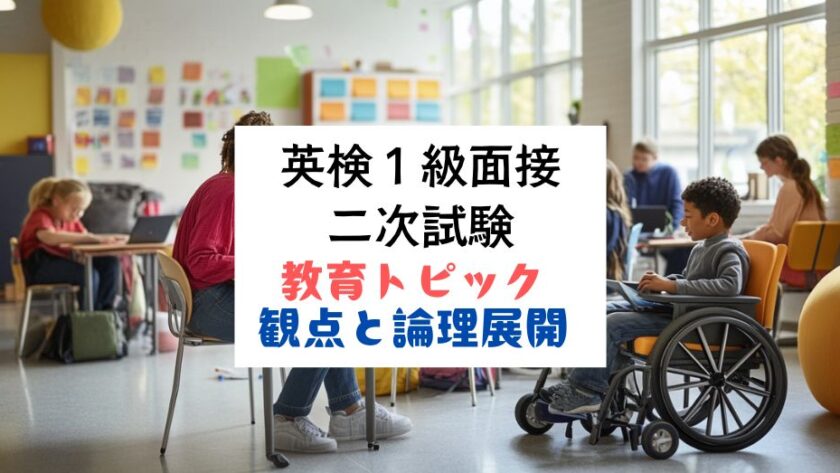目次
- 1 試験概要と流れ
- 2 トレーニング手順
- 3 二次試験予想問題
- 4 模範解答の観点整理とサンプル回答
- 5 1. Should the school curriculum focus more on practical skills than academic knowledge?
- 6 2. Is homeschooling an effective alternative to traditional schooling?
- 7 3. Will Educational Inequality Disappear?
- 8 4. Should higher education be free for all citizens?
- 9 5. Will Inclusive Education Become Common in the Future?
- 10 英作文(意見論述・要約問題)対策テキスト
試験概要と流れ
- 入室
- 「面接カード」を渡す
- 着席
- 氏名の確認と簡単な日常会話
- 「トピックカード」を受け取る:様々な分野が混ざっている
- スピーチ準備(1分間)
- スピーチ(2分間):概ね180〜240語(話すスピードによって異なる)
- Q&A(4分間)
スピーチの内容に関する2-3の質問 - 「トピックカード」返却
- 退室
トレーニング手順
- カテゴリー(分野)毎に観点とキーワード整理(10分程度)
- 実際にスピーチをして録音して聞き直す(2分+聞き直し)
- 満足できるまで数回繰り返す
- カテゴリー別に話せる様になったら本番形式(トピックが混ざったカード)でトレーニングを行う
二次試験予想問題
質問文を見て、連想される観点・キーワードを書き出してみましょう
トレーニング用に同じ分野のトピックを5つ記載していますが、実際のトピックカードは、5つの異なる分野から出題されます。
- Should the school curriculum focus more on practical skills than academic knowledge?
- Is homeschooling an effective alternative to traditional schooling?
- Will Educational Inequality Disappear?
- Should higher education be free for all citizens?
- Will Inclusive Education Become Common in the Future?
- 学校のカリキュラムは、学問的な知識よりも実践的なスキルに重点を置くべきですか?
- ホームスクーリングは従来の学校教育の有効な代替手段ですか?
- 教育格差はなくなるでしょうか?
- 高等教育はすべての市民に無料で提供されるべきですか?
- 将来的にインクルーシブ教育が一般的になるか?
模範解答の観点整理とサンプル回答
対策初期は、トピック毎に観点整理をするのが効果的です。
色々なトピックについて観点とキーワード整理をしていくうちに、ざっくりと自分の中で分野ごとの語いの引き出しが増えてきます。
それでは質問ごとに「観点とイメージ画像・サンプル論理展開・サンプル回答・対訳」を表示していきますので、お好きな質問からご覧ください。
1. Should the school curriculum focus more on practical skills than academic knowledge?
学校のカリキュラムは、学問的な知識よりも実践的なスキルに重点を置くべきですか?
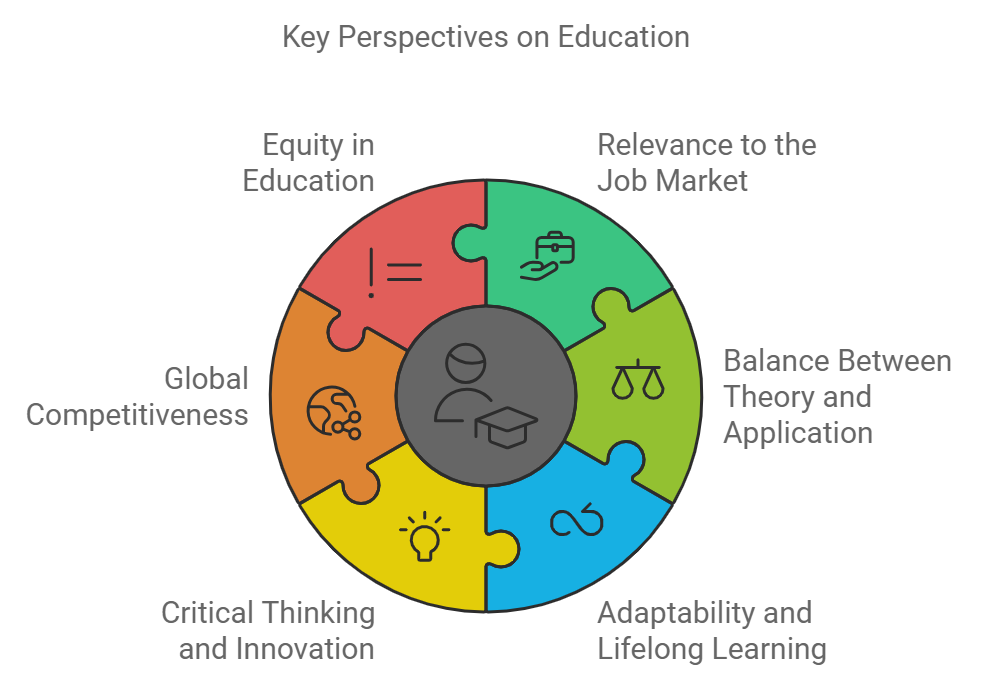
観点 (Perspectives)
- Relevance to the Job Market (労働市場への関連性)
- Practical skills, such as problem-solving, communication, and technical proficiency, are highly valued by employers and may better prepare students for future employment than purely academic knowledge.
- Balance Between Theory and Application (理論と応用のバランス)
- A well-rounded curriculum should balance academic knowledge with practical skills to foster both intellectual growth and real-world problem-solving abilities.
- Adaptability and Lifelong Learning (適応力と生涯学習)
- Practical skills encourage adaptability and flexibility in a rapidly changing world, enabling students to continuously learn and apply new knowledge throughout their lives.
- Critical Thinking and Innovation (批判的思考とイノベーション)
- Academic knowledge cultivates critical thinking, a skill necessary for innovation and scientific discovery, which practical skills alone may not fully develop.
- Global Competitiveness (国際競争力)
- In a globalized economy, practical skills in technology, languages, and cross-cultural communication are essential for ensuring a nation’s workforce remains competitive.
- Equity in Education (教育の公平性)
- Focusing too heavily on practical skills may widen the gap between students with different socioeconomic backgrounds, as some may lack access to opportunities for developing these skills outside of school.
キーワード (Keywords)
- vocational training (職業訓練)
- soft skills (ソフトスキル)
- technical proficiency (技術的熟練)
- problem-solving (問題解決)
- critical thinking (批判的思考)
- lifelong learning (生涯学習)
- theoretical knowledge (理論的知識)
- intellectual development (知的発達)
- employment readiness (就業準備)
- global competitiveness (国際競争力)
使われそうな動詞 (Verbs)
- enhance (強化する)
- prioritize (優先する)
- equip (備えさせる)
- cultivate (育てる)
- adapt (適応する)
- foster (育成する)
- balance (バランスを取る)
- integrate (統合する)
- reinforce (補強する)
- bridge (橋渡しする)
使われそうな形容詞 (Adjectives)
- practical (実践的な)
- holistic (包括的な)
- vocational (職業の)
- applicable (応用可能な)
- theoretical (理論的な)
- well-rounded (全体的にバランスの取れた)
- essential (不可欠な)
- innovative (革新的な)
- job-ready (就業準備が整った)
- multidisciplinary (学際的な)
使われそうな副詞 (Adverbs)
- effectively (効果的に)
- holistically (包括的に)
- practically (実践的に)
- theoretically (理論的に)
- competitively (競争力を持って)
- dynamically (動的に)
- adaptively (適応的に)
- critically (批判的に)
- proactively (積極的に)
- strategically (戦略的に)
論理展開・観点
- 実践的スキルの重要性:キャリアに直結するスキル(プログラミング、会計など)を学ぶことで、卒業後の即戦力となる。
- 学問的知識の価値:批判的思考や問題解決能力を育て、幅広い教養を提供する。
- バランスの必要性:実践的スキルと学問的知識の両方が必要であり、一方に偏るべきではない。
Should the School Curriculum Focus More on Practical Skills than Academic Knowledge?
I believe that school curricula should strike a balance between practical skills and academic knowledge.
First, practical skills are essential for students to succeed in the modern workforce. For example, learning skills like programming, financial management, or even communication skills can help students become more competitive in the job market. These skills are often directly applicable in real-life situations, making students more prepared for life after school.
However, academic knowledge also plays a critical role in education. Subjects like history, literature, and mathematics help develop critical thinking, creativity, and problem-solving skills. These are important not only in professional settings but also for personal growth. Academic knowledge provides students with a foundation to understand the world and think analytically, which is valuable in any career.
In conclusion, both practical skills and academic knowledge are necessary for a well-rounded education. Schools should aim to provide students with a balanced curriculum that prepares them for both the job market and lifelong learning. (159 words)
学校のカリキュラムは、学問的な知識よりも実践的なスキルに重点を置くべきか
私は、学校のカリキュラムは実践的なスキルと学問的知識のバランスを取るべきだと考えています。
まず、実践的なスキルは、現代の職場で成功するために欠かせません。たとえば、プログラミングや財務管理、さらにはコミュニケーションスキルを学ぶことで、学生は就職市場で競争力を持つことができます。これらのスキルは現実の生活に直接役立ち、卒業後の人生に備えることができます。
しかし、学問的な知識も教育において重要な役割を果たします。歴史や文学、数学などの科目は、批判的思考や創造力、問題解決能力を育てます。これらの能力は職場だけでなく、個人的な成長にも役立ちます。学問的知識は、学生に世界を理解し、分析的に考える基盤を提供し、どのような職業でも価値があります。
結論として、実践的なスキルと学問的な知識の両方が、充実した教育には必要です。学校は、就職市場と生涯学習の両方に備えたバランスの取れたカリキュラムを提供するべきです。
2. Is homeschooling an effective alternative to traditional schooling?
ホームスクーリングは従来の学校教育の有効な代替手段ですか?
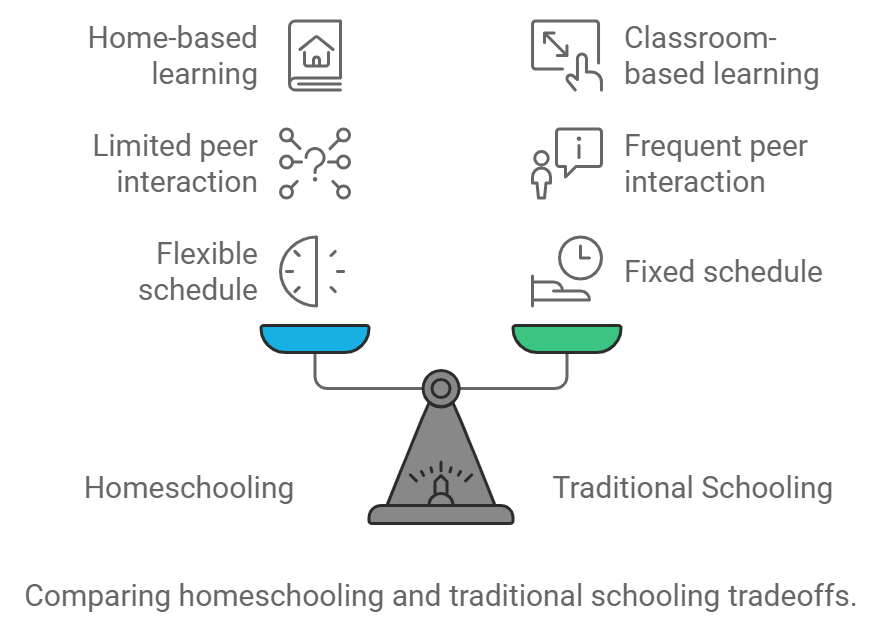
模範解答の論理展開・観点
- ホームスクーリングの利点:個別のニーズに対応した教育が可能で、家庭環境に合った学習ができる。
- 従来の学校教育の強み:社会的スキルや協働学習の機会を提供し、同年代の子どもたちと交流できる。
- 両者の組み合わせの可能性:どちらか一方だけではなく、家庭教育と学校教育を組み合わせた柔軟なアプローチも有効。
Is Homeschooling an Effective Alternative to Traditional Schooling?
I believe that homeschooling can be an effective alternative to traditional schooling, but it depends on the individual circumstances.
One advantage of homeschooling is that it allows parents to tailor the education to the specific needs and interests of the child. This can be particularly beneficial for students who struggle in traditional classrooms or who have special educational needs. Homeschooling also provides flexibility, allowing students to learn at their own pace and explore subjects in more depth.
However, traditional schooling offers benefits that homeschooling may lack. Schools provide opportunities for social interaction, where students can develop important social skills and learn how to collaborate with others. Participating in group activities, clubs, and sports teams helps students build friendships and learn teamwork, which are essential for personal and professional development.
In conclusion, homeschooling can be an effective option for some families, but it is important to consider the social and collaborative aspects of traditional schooling. A balanced approach that incorporates elements of both homeschooling and traditional education may provide the best results for students. (173 words)
ホームスクーリングは従来の学校教育の有効な代替手段か)
私は、ホームスクーリングが従来の学校教育の有効な代替手段となる場合があると考えていますが、それは個々の状況によります。
ホームスクーリングの利点の一つは、親が子どもの特定のニーズや興味に合わせて教育をカスタマイズできることです。これは、従来の教室でうまくいかない学生や、特別な教育的ニーズを持つ学生にとって特に有益です。また、ホームスクーリングは柔軟性があり、生徒は自分のペースで学習し、興味のある分野をより深く探求することができます。
一方で、従来の学校教育は、ホームスクーリングでは得られないメリットを提供します。学校では、学生が社会的スキルを身につけ、他者と協力する方法を学ぶための交流の機会が提供されます。グループ活動やクラブ、スポーツチームへの参加を通じて、学生は友人を作り、チームワークを学ぶことができます。これらのスキルは、個人的および職業的な発展に不可欠です。
結論として、ホームスクーリングは一部の家庭にとって効果的な選択肢となり得ますが、従来の学校教育が提供する社会的および協力的な側面も考慮する必要があります。ホームスクーリングと従来の教育を組み合わせた柔軟なアプローチが、学生にとって最良の結果をもたらすかもしれません。
3. Will Educational Inequality Disappear?
教育格差はなくなるか?
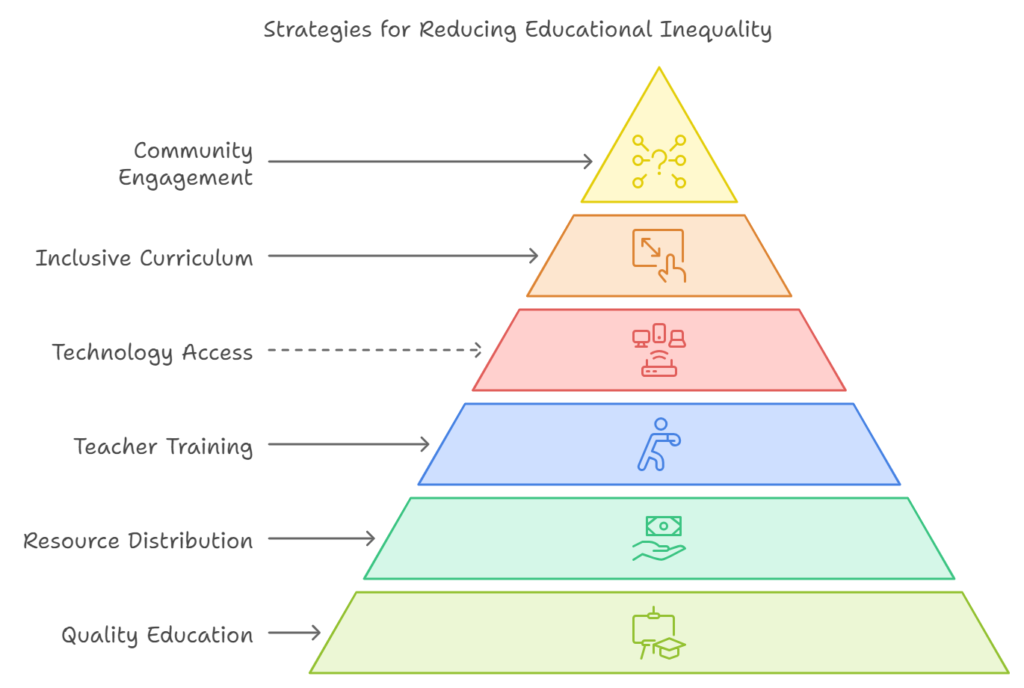
Perspectives on Reducing Educational Inequality
- Access to Quality Education
Ensuring that all students, regardless of their socioeconomic background, have access to high-quality education and resources, including well-trained teachers and up-to-date facilities. - Equitable Distribution of Resources
Addressing disparities in funding between schools in wealthy and disadvantaged areas, and providing additional resources to underserved communities. - Teacher Training and Support
Improving teacher training and offering continuous professional development, especially in underfunded schools, to ensure educators are equipped to support diverse learners. - Technology and Digital Access
Bridging the digital divide by ensuring all students have access to technology, internet connectivity, and digital literacy skills, which are essential for modern learning. - Inclusive Curriculum and Pedagogy
Developing curricula that reflect diverse cultures, experiences, and learning styles, while using teaching methods that engage all students equally, regardless of their background. - Parental and Community Engagement
Encouraging greater involvement from parents and communities in the education process, particularly in low-income areas, to build stronger support networks for students.
模範解答の論理展開・観点
- テクノロジーの力:デジタルツールやオンライン学習によって、教育資源が世界中に広がり、教育格差が縮まる可能性がある。
- デジタルデバイドの問題:すべての学生がインターネットやデジタルデバイスにアクセスできるわけではなく、格差が残る可能性がある。
- 政府と民間の支援:教育格差を解消するためには、政府や民間企業の支援が不可欠であり、特にインフラ整備が重要。
Will Educational Inequality Disappear?
I believe that while technology has the potential to reduce educational inequality, it is unlikely to disappear completely. One reason is that digital tools and online learning platforms can make educational resources more accessible to students around the world. In regions where schools and teachers are limited, students can access high-quality education through the Internet. This helps level the playing field, giving students in remote or underprivileged areas the same opportunities as those in wealthier regions.
However, the digital divide remains a significant challenge. Not all students have access to the Internet or the necessary devices to take advantage of online education. This lack of access can widen the gap between those who can use technology for learning and those who cannot. For true educational equality, it is essential to ensure that all students have the same access to technology.
Finally, governments and private organizations must work together to eliminate educational inequality. Investment in infrastructure, such as providing Internet access to rural areas, and offering financial support for students who cannot afford technology will be key steps. In conclusion, while educational inequality may not disappear entirely, targeted efforts can significantly reduce the gap. (193 words)
教育格差はなくなるか
私は、テクノロジーが教育格差を縮小する可能性を持っているものの、完全になくなることはないと考えています。一つの理由は、デジタルツールやオンライン学習プラットフォームが、世界中の学生に教育資源をよりアクセスしやすくしていることです。学校や教師が限られている地域でも、インターネットを通じて質の高い教育にアクセスできるようになりました。これにより、恵まれない地域の学生も、裕福な地域の学生と同じような機会を得られるようになり、教育の公平性が向上します。
しかし、デジタルデバイド(情報格差)は依然として大きな課題です。すべての学生がインターネットや必要なデバイスにアクセスできるわけではありません。このアクセスの欠如は、テクノロジーを学習に活用できる学生とそうでない学生の間で、さらなる格差を生み出す可能性があります。真の教育平等を実現するためには、すべての学生がテクノロジーに同じようにアクセスできるようにすることが重要です。
最後に、教育格差を解消するためには、政府と民間の組織が協力する必要があります。インターネットアクセスを提供するためのインフラ整備や、テクノロジーを利用できない学生への経済的支援は重要なステップです。結論として、教育格差が完全になくなることは難しいかもしれませんが、的確な取り組みによって格差を大幅に縮小することは可能です。
※ level the playing field: 「競争の場を平等にする」
4. Should higher education be free for all citizens?
高等教育はすべての市民に無料で提供されるべきですか?
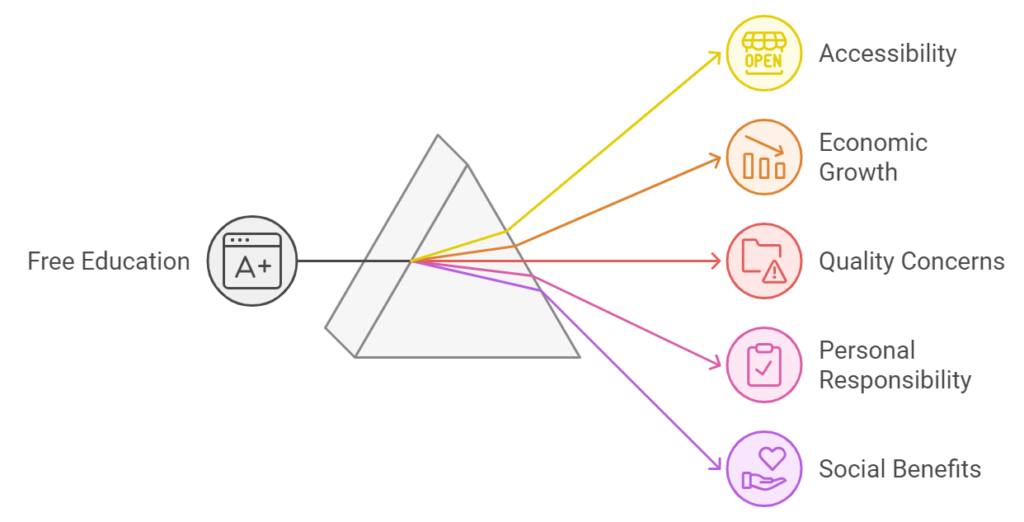
教育無料化の観点
- Equal Access to Education
Free education ensures that all individuals, regardless of their socioeconomic background, have access to quality learning opportunities, promoting fairness and reducing inequality. - Economic Impact and National Growth
Free education can contribute to long-term economic growth by producing a more educated workforce, fostering innovation, and increasing national productivity. - Government Expenditure and Budget Constraints
Implementing free education requires significant government investment, which could strain public finances and lead to higher taxes or cuts in other essential services. - Quality of Education
While free education increases accessibility, there is a risk that the quality of education might decline if institutions face underfunding or overcrowding due to increased enrollment. - Personal Responsibility and Motivation
Some argue that paying for education fosters a sense of personal investment and responsibility, and that free education may reduce students’ motivation to fully engage with their studies. - Long-term Social Benefits
Free education can lead to a more informed and engaged citizenry, reduce crime rates, and promote social stability, as educated individuals are more likely to contribute positively to society.
模範解答の論理展開・観点
- 無料化の利点:すべての人に平等な教育機会を提供し、経済的格差を是正する。
- 無料化のコスト:政府の財政負担が増え、他の公共サービスに影響を与える可能性がある。
- 持続可能な方法:無償化以外にも、奨学金制度や学費の一部免除など、持続可能な形での支援が必要。
Should Higher Education Be Free for All Citizens?
I believe that higher education should be free for all citizens, but it should be implemented carefully to ensure sustainability. One of the main advantages of free higher education is that it provides equal opportunities for all, regardless of their financial situation. Many talented students cannot afford to attend university, and free education would help bridge this gap. This could lead to a more educated workforce, which benefits society as a whole.
However, free higher education comes with significant costs. Governments would need to allocate a large portion of their budget to fund universities and other higher education institutions. This could lead to cuts in other important public services, such as healthcare or infrastructure. To avoid this, governments could explore alternative solutions, such as providing scholarships or offering partial subsidies for tuition fees.
In conclusion, while free higher education is a noble goal, it is essential to consider the financial impact it could have on the economy. A balanced approach, such as offering financial aid to those in need while maintaining tuition fees for others, may be a more sustainable solution. (181 words)
高等教育はすべての市民に無料で提供されるべきか
私は、高等教育はすべての市民に無料で提供されるべきだと考えていますが、それは持続可能性を考慮して慎重に実施されるべきです。高等教育を無料化する主な利点の一つは、経済状況に関係なく、すべての人に平等な教育機会を提供できることです。多くの才能ある学生が、大学に通う余裕がなく、無料教育はこのギャップを埋める助けとなります。これにより、社会全体に利益をもたらす、より教育を受けた労働力が生まれるでしょう。
しかし、高等教育の無料化には大きなコストが伴います。政府は大学や他の高等教育機関に資金を提供するために、予算の大部分を割り当てる必要があります。これにより、医療やインフラなどの他の重要な公共サービスに影響が出る可能性があります。この問題を避けるために、政府は奨学金の提供や、授業料の部分的な補助などの代替策を検討することができます。
結論として、高等教育の無料化は高い理想ですが、経済に与える影響も考慮する必要があります。経済的に困難な学生には経済支援を提供し、他の学生には授業料を維持するというバランスの取れたアプローチが、より持続可能な解決策かもしれません。
5. Will Inclusive Education Become Common in the Future?
将来的にインクルーシブ教育が一般的になるか?
インクルーシブ教育とは、すべての生徒が学び合える学校環境を目指す教育の仕組みです。特別な支援が必要な生徒も含め、全員が同じ教室で学べるようにし、個々のニーズに応じたサポートを提供します。これにより、障害を持つ生徒や異なる学習スタイルを持つ生徒も、周りの生徒と一緒に成長し、協力しながら学ぶことができます。目標は、多様性を尊重し、平等な学びの機会を提供することです。
模範解答の論理展開・観点
- インクルーシブ教育の進展:教育の平等性と社会的包摂が重要視され、インクルーシブ教育が世界的に推進されている。
- 現在の課題:教育現場のリソースや教員の専門知識が不十分であり、すべての生徒に対して適切なサポートを提供するには改善が必要。
- 将来的な可能性:技術の進歩や政策の変更により、インクルーシブ教育がより一般的になり、すべての生徒に平等な学習機会が提供される可能性がある。
Will Inclusive Education Become Common in the Future?)
I believe that inclusive education will become more common in the future, as societies increasingly recognize the importance of equality and inclusion. Inclusive education means that students of all abilities, including those with disabilities, learn together in the same classrooms. This approach promotes social integration and helps all students develop empathy and understanding of diversity. Many countries are already adopting policies to make inclusive education the standard, and there is growing awareness of its benefits.
However, there are still challenges to fully implementing inclusive education. One issue is that many schools lack the necessary resources, such as specialized teachers or adaptive technology, to support students with diverse needs. Additionally, some teachers may not have the training required to effectively teach students with different abilities. Addressing these challenges will be crucial for making inclusive education more widespread.
In the future, with advances in technology and improvements in teacher training, inclusive education could become the norm. Governments and schools need to invest in resources and training to ensure that all students, regardless of their abilities, receive the support they need to succeed.
In conclusion, while there are still obstacles, the trend toward inclusive education is likely to grow, making it a more common approach in the future. (205 words)
将来的にインクルーシブ教育が一般的になるか)
私は、インクルーシブ教育は将来的により一般的になると考えています。なぜなら、社会全体で平等性と包摂の重要性がますます認識されているからです。インクルーシブ教育とは、障害のある生徒を含め、すべての生徒が同じ教室で一緒に学ぶ教育方式です。このアプローチは、社会的な統合を促進し、多様性に対する共感と理解を深めるのに役立ちます。すでに多くの国がインクルーシブ教育を標準とする政策を採用しており、その利点への認識も高まっています。
しかし、インクルーシブ教育の完全な実施にはまだ課題があります。一つの問題は、多くの学校が多様なニーズを持つ生徒を支援するためのリソース(専門教師や適応技術など)を十分に備えていないことです。さらに、一部の教師は、異なる能力を持つ生徒を効果的に教えるための訓練が不足している場合もあります。これらの課題に対処することが、インクルーシブ教育を普及させるために重要です。
将来的には、技術の進歩や教師の訓練の改善により、インクルーシブ教育が標準的になる可能性があります。政府や学校がリソースや訓練に投資し、すべての生徒がその能力にかかわらず、成功するために必要なサポートを受けられるようにすることが必要です。
結論として、まだ障害はありますが、インクルーシブ教育の普及は今後さらに進み、より一般的なアプローチとなるでしょう。
単語・フレーズ・文法表現解説
- inclusive education: 「インクルーシブ教育」。すべての生徒が同じ教室で学ぶ教育方法を表す重要なフレーズ。
- social integration: 「社会的統合」。インクルーシブ教育によって、障害のある生徒が社会に統合されることを説明する表現。
- adaptive technology: 「適応技術」。障害のある生徒が学習を進めるために使われる技術を指すフレーズ。
- diverse needs: 「多様なニーズ」
- become the norm: 「標準となる」
英検1級英作文(意見論述・要約問題)・二次試験(面接)リストはコチラ
英検1級トピック探しにおススメのサイト:Britanica ProCon.org
英作文(意見論述・要約問題)対策テキスト
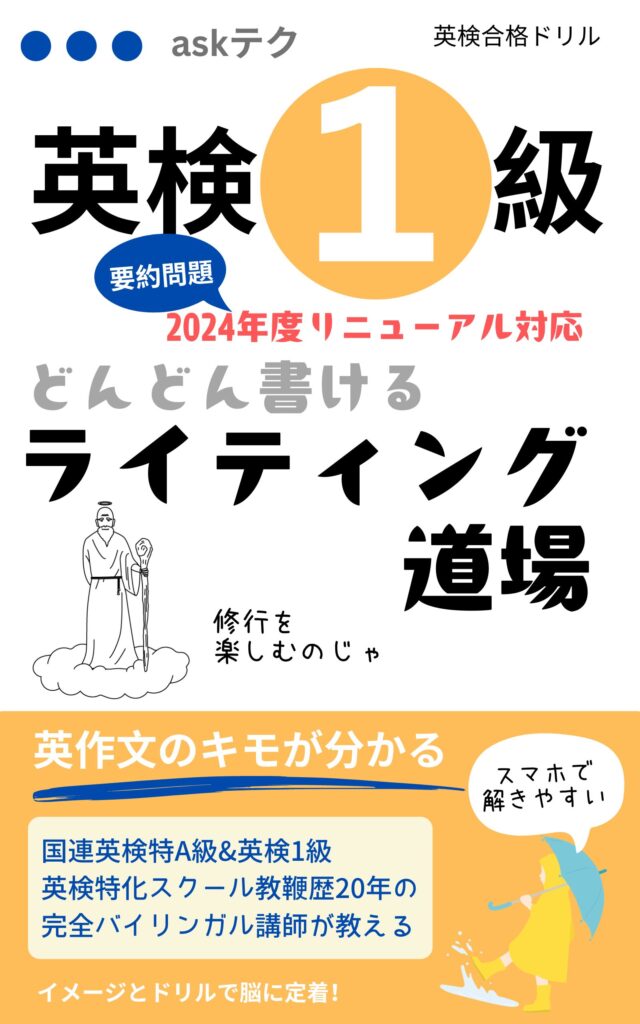
「どんなテキストがおすすめですか?」とよく聞かれるのですが、「問題量が多い」ものと「知識量を増やせるもの」の2種類を準備すると良いかと思います。
また、あまりにも文法解説が長いテキストは、英検1級対策としては、「?」という感じがします。
「何を、どんな観点で、どう伝えるか」にフォーカスして書かれたテキストを選んでください。
英作文テキストは、「最低でも3ラウンドする」。語彙や表現を増やす系のテキストは「最低でも5ラウンドする」つもりで、1ページごとに時間をかけすぎず、分からない時はすぐにググりながらテンポよく進めていきます。

